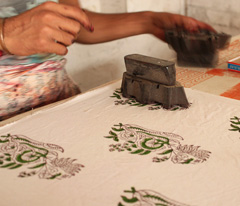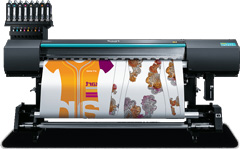| HISTORY OF FABRIC PRINTING |
 |
|
It this article, we will explore the History of Fabric Printing from the Ancient time to this day.
|
| Origins and Early Development |
 |
|
The tradition of decorating fabrics using different printing techniques is almost as long as civilization itself. Namely, surviving pictorial sources indicate that printed fabrics were widely in use in Ancient Egypt, dating back as early as 5000 B.C. Early writings state that Alexander the Great found colourful printed textiles during his Indian campaign in 327 B.C. However, the earliest surviving examples of printed fabric originate from China, dating to before 220. These early prints were typically made by using woodblock printing method, in which designs were engraved on the surface of a wooden block.
By the end of the 3rd century, another printing method was introduced in China and further developed in Japan-stencil printing. The pattern was transferred to fabric through the open areas of a stencil cut usually made in thin metal or cardboard. Batik, the Indonesian technique of hand-printing textiles by coating the parts which are not to be dyed with wax, was already developed in the 7th century. Nowadays batik serves as a generic term for the process of dyeing fabric via resist techniques. Japanese shibori is yet another resist dyeing technique, with its earliest surviving examples dating back to the 8th century. Textile printers used to fold, stitch, bind, or knot fabric before dyeing it, most often with indigo dye. Interestingly enough, Ancient Latin American civilizations-Aztecs of Mexico and Inkas of Peru-were known to use fabric printing prior to Spanish conquest in 1519. Unfortunately, due to the lack of recorded information, not much is known about the techniques they used. In the Islamic world, archaeologists identified printing blocks originating from the Fatimid period (909-1171), while in the 16th century printing industries were already established in Anatolia and Syria, stimulated by the growing export of Indian textile prints to Europe.
|

Block Printing on Fabric
|
| Fabric Printing Industry in Europe: 17th-19th Century |
 |
|
By the 17th century, Asian printed textiles had been popularized in Europe. The French port of Marseille was the starting point, where they were first introduced by Armenian merchants. Later on, printed textiles were directly imported from English and French colonies in South and East Asia. Moreover, renowned East India Company was, among other products, specialized for the import of printed cotton from India. Due to the immediate popularity of printed textiles and high transportation costs, it did not take long until the method for colourfast textile printing was developed in Europe.
Regardless of the fact that it was developed by 1670s, textile printing on a large scale was not successful until the late 18th century. Namely, in order to protect dominant silk weaving industry, textile printing was banned in France until 1759 and in England until 1774. In spite of the ban, a number of important technological advancements were achieved during that period. To begin with, engraved copperplates for printing were first introduced in Ireland in 1752. They enabled the serial production of monochrome, mostly red and blue textile prints, typically decorated with mythological motifs and floral designs. Immediately after France lifted the ban, industrialist Christophe Oberkampf founded the Royal Manufacture of printed cottons in Jouy-en-Josas near Paris. The number of employees reached 900 within only five years, and the prints featuring floral and chinoiserie motifs quickly grew in popularity, leaving a noticeable impact on the aesthetics of that period.
In 1783, roller printing machine was invented by Thomas Bell of Scotland. It mechanized the process of fabric printing, which practically meant that one roller printing machine could print as much as twenty block printers. With some improvements, this machine was soon able to print calico fabric in two to six colours in a single operation. While roller printing machine dominated in the U.K. textile printing industry throughout the 19th century, in Continental Europe the so called perrotine machine was much more popular. Invented in 1834, it is a mechanism for the automatization of block printing process, and to the present date practically the only successful device introduced for that purpose. It could only be implied in the printing of patterns containing no more than three colours nor exceeding five inches in vertical repeat. Fabric printing process was also highly affected by the discovery of synthetic dyes. The first one-mauve-was synthesized in 1856 by English chemist William Perkin. By 1900s, around 700 colours were already available at the market.
|
|
| Fabric Printing in the 20th Century |
 |
|
Due to the continuous technological advancements, printed textiles gradually became more affordable, and therefore, more popular. Moreover, that popularity would grow even more during the 20th century, primarily thanks to the invention of screen and digital textile printing. The technique of screen printing was developed in the French city of Lyon in 1930s. Its operational principle is rather simple-a fine gauze mesh, later replaced by polyester or polyamide, is tightly stretched onto a frame, while the lacquer is used to block the dye on the parts where it is unwanted. The frame is then placed on a fabric for the dye to be forced through the mesh. By 1950s, the entire process was mechanized. Rotary screen printing machine, which basically consists of a flat screen shaped into a roll, was invented in Germany in 1962. It uses a nickel cylinder designed to hold the dye and release it through its small openings. Due to these two inventions, textile printing industry was revolutionized twice in less than 30 years.
When it comes to revolutionizing textile printing industry, it is clear that the biggest advancement took place at the very end of the 20th century. The digitalization of the overall textile industry also affected the printing techniques. Namely, digital textile printing has been introduced as the replacement for analog screen printing. To this day, two dominant printing methods have been developed-direct to garment and dye sublimation printing. As its name suggests, direct to garment printing is a method of printing dyes directly on fabric, whereas the process of dye sublimation incorporates the usage of transfer paper in order to infuse dye into fabric. Both methods have widened the applications of textile printing, and nowadays it is used for decorating household items, such as curtains and table covers, T-shirts, banners, sportswear, flags, industrial applications, and so on.
Numerous customization possibilities have recently stimulated the growth of the textile printing industry. In 2016, the global value of digital printing industry was $2 billion, and it is expected to double until 2021, making it one of the fastest growing industries in the world.
For more information on Fabric Printing, check out our articles below:
For more information on Sublimation Printing on Texttiles with is Click Here!
|

Digitalization of Fabric Printing (ie. Texart XT-640 Dye-Sublimation Printer)
|
|
If you have questions about any of our services or products, don't hesitate to contact us. Our knowledgeable staff is always happy to assist with answers, advice, or suggestions.
|
|

|



|
USA Giclee On Canvas, Fine Art Printing - Art Scanning & Reproductions - Handmade Oil Paintings - Custom Wood Panels, Metal Picture Framing - Block/Plaque Mountings, Large Format Dry Mounting & Lamination - Art Supplies: Stretcher Bars, Cradled Wood Panels and Artist Canvas - Collages On Canvas - Plexi/Acrylic Face Mounts - Block Acrylics, Fabric Printing, Dye Sublimation - Cityscape Skyline Prints, Resin, Photo Gifts and more...
|
|
© 2002-2025 - KeenART Media Ltd.
|
|
| |
|
